Filtron, ceramic filter for drinking water
Filtrón in practice
FILTRÓN is a very inexpensive product. The filter can be made by local potters using local materials, with no need for electricity or advanced technology. It consists of a mixture of 50% red clay and 50% sawdust, or similar organic material such as rice husk or coffee husk, depending on locally available material. Water is added to the mixture, which is then placed into a mould. This is then pressed using a truck jack, which is something that can be easily found.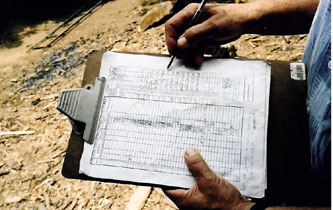
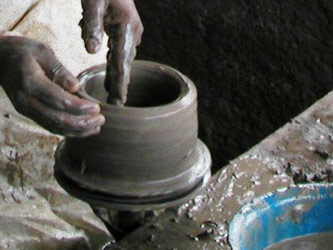
Once dry, the filters are fired in a potter’s kiln at 890 degrees centigrade. This creates a membrane of tiny pores that stops bacteria from getting through. Next, the filter is soaked in a solution of colloidal silver to prevent bacterial growth. This process makes the water drinkable and removes turbidity. To use FILTRÓN, the filter is filled with water and covered with a lid. Standard filtration rate is between one and two litres an hour. If a greater amount of water collects in less time, it is sign that there is something wrong with the filtering process.
The table on the previous page shows how much bacteria is blocked by FILTRÓN micro pores.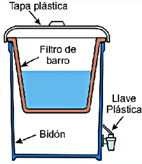
Personnel and equipment needed to set up a filter workshop
• 1 professional potter with experience in collecting clay and making ceramic articles, semi-industrial and mass production
• 1-2 assistants, preferably potters
• 15 to 20-ton hydraulic press
• Filter moulds
• Clay and sawdust mixer
• Hammer mill
• Kiln with an internal area of at least one cubic metre
• Colloidal silver
• Racks, workbenches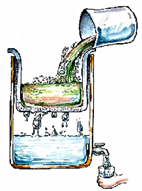
A complete FILTRÓN unit also requires:
• Plastic water tap
• 20-30 litre ceramic tank made locally or 20-30 plastic buckets with lids (which can be purchased locally)
• Instructions for use, preferably printed on the bucket or written on a waterproof transfer
• Micro biological tests (HACH)
• At least 100-square metres of covered area to begin operations
Description of the manufacturing process
The process begins by grinding dry clay in a hammer mill; the milled clay is then passed through a fine screen mesh (size 30, like a mosquito net) to remove larger particles and any other impurities that the clay might contain. 60 lbs of clay are weighed on a scale (27.3 kg). The sawdust is also dried and is passed through the mesh (size 30) and the equivalent of 12 lbs is weighed (5.443 Kg).
Then both sawdust and clay are dry mixed for ten minutes either by hand or in a mixer at a speed of 60 rpm. Then, about 2.5 gallons of water (9.4 litres) are slowly added. It is mixed for another ten minutes until a homogenous consistency is obtained. Then the mixture is shaped into 16-pound balls and taken to a hydraulic press where it is placed in purpose-built moulds.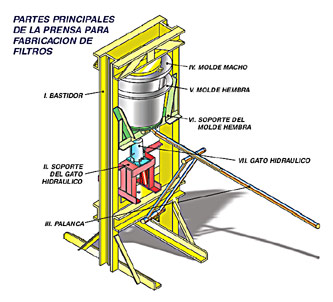
The mould consists of male and female sections and a plate to facilitate removal of the filter once it has been pressed. The male and female parts are covered with plastic to prevent the clay mixture from sticking to the mould and getting damaged. Then, the filters are placed on drying racks for one day.
The second day each filter is stamped with the workshop name and serial number. This is done for purposes of quality control on each piece; a register is kept of all filters delivered to each customer. Folds in the clay due to the plastic covering in the mould are smoothed out with a tool.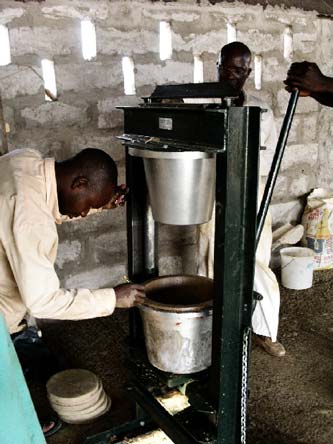
Depending on the weather, the fresh filters are left to dry for a period of between 5 and 21 days. Nicaragua has special drying rooms where they can be dried in four days throughout the year. Once the filters are completely dry, they are fired in a kiln at a temperature of 890 °C for 9 hours. A digital pyrometer is used to ensure that the temperature is correct and pyrometric cones are used to make any necessary adjustments. Afterwards, the filters are left to cool in the kiln until they reach room temperature. Then the pots are taken out of the kiln and placed on racks for semi-finished products.
Once cool, they are soaked in water overnight so that the water permeates all the pores that have been formed by firing the sawdust. Then a test is carried out to check the filtration rate, which must be between one and two litres an hour. Any filters that do not meet this requirement are destroyed.
Records of the tests are kept in a book together with the serial number for each filter, production date, the date it was fired and the filtration rate.
Next, a mixture of water and colloidal silver is prepared. Two millilitres of colloidal silver at 3.2% is added to 250 millilitres of water. When the filter is perfectly dry it is dipped into the solution; alternatively the solution can be applied using a brush.
Pictures illustrating the production process can be found at www.elfiltron.com in the important documents section.
DOWNLOAD THE BROCHURE PDF
Spanish (0.5 MB)English (0.5 MB)








 COUNTRY OF ORIGIN
COUNTRY OF ORIGIN